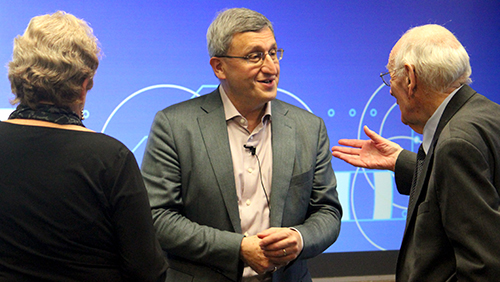Innovation: It’s More Than a Buzzword
Earth-shattering innovations rarely happen in a vacuum. From Sputnik to Apollo 11, the Model T to self-driving cars, steam locomotives to maglev trains, every transportation technology that challenged us to rethink mobility rose out of entire teams of engineers and designers who bucked convention.
Teams that achieve breakthrough innovations have three key things in common, according to Ken Gabriel, president and CEO of Draper, who spoke as part of Volpe’s Reimagining Transportation series.
First, innovative teams have the best employees, or “jumpers,” who may come from other organizations or industries and are attracted by the chance to work on big, bold projects.
They are also independent from organizational constraints and micro-oversight, so they can uproot common knowledge.
And, they don’t sit on their hands.
 “Having spent time in the government, spent time in the private sector, there’s always a tendency to slow down for whatever reason,” Gabriel said. “It’s really important to move fast, because teams go away, opportunities go away, people leave—and they are a vital part of making things happen.”
“Having spent time in the government, spent time in the private sector, there’s always a tendency to slow down for whatever reason,” Gabriel said. “It’s really important to move fast, because teams go away, opportunities go away, people leave—and they are a vital part of making things happen.”
Crumpling Up the Blueprint
Teams that push for innovation can achieve innovation, but Gabriel’s recipe for fostering breakthroughs is often passed over in favor of a simpler, more commonly accepted approach: the linear model of innovation, where basic science leads to applied science which leads to commercialization.
The linear model assumes that there is a single path or roadmap to achieve innovation. It is slow—and it is at least 20 years out of date, Gabriel said. Because it is so prescriptive, team leaders working within this model rarely encourage ideas that run counter to accepted wisdom.
“If you’re going to have a significant impact on the 32,000 people that are killed every year in accidents, it’s not going to happen from a technology roadmap,” Gabriel said. “That’s my submission. If you want to do something that is going to make a significant impact, it’s going to go through something that defies this process.”
DIY? Why?
 Before joining Draper, Gabriel helped establish Google’s strategic research arm, the Advanced Technology and Projects (ATAP) group, which has produced prototypes for smart fabric, build-it-yourself smartphones, and devices that can map the immediate physical world—say, inside a museum—with a human-scale understanding of space and motion.
Before joining Draper, Gabriel helped establish Google’s strategic research arm, the Advanced Technology and Projects (ATAP) group, which has produced prototypes for smart fabric, build-it-yourself smartphones, and devices that can map the immediate physical world—say, inside a museum—with a human-scale understanding of space and motion.
During Gabriel’s time as ATAP deputy director, the mapping project had only about a half-dozen employees on staff. But, the project also partnered with more than 40 organizations in academia and in the public and private sectors. Collaboration with companies big and small across four continents with hundreds of their own employees gave ATAP staff the flexibility to drive toward the next big thing.
“If we had had to hire that capability into Google, hiring 400 people and getting them facilities and equipment, we would still be pulling that project together,” Gabriel said. “That’s a really important part of getting these things done: not doing it all yourself, but to drive and manage it yourself.”
